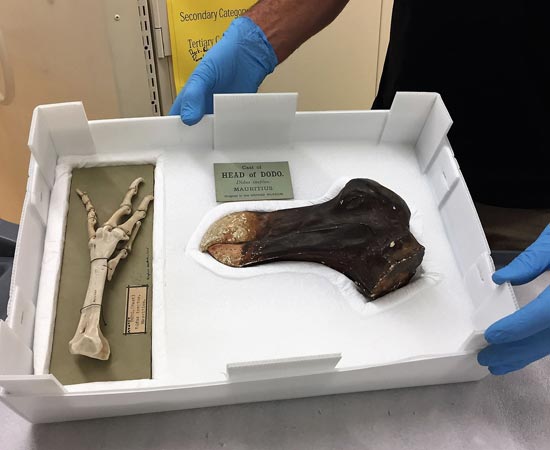A New New Zealand Pigeon from the Miocene
The Zealandian Dove Related to the Dodo
Scientists from the Canterbury Museum (New Zealand), in collaboration with colleagues from the University of New South Wales, Flinders University and the Museum of New Zealand Te Papa Tongarewa, have described a new species of prehistoric pigeon that flapped around South Island during the Miocene Epoch, some 16-19 million years ago. The new species has been named the Zealandian Dove (Deliaphaps zealandiensis) and it may have been related to the extinct, giant, flightless pigeon of Mauritius – the Dodo.
Part of the Dodo Collection from the Canterbury Museum
Picture credit: Canterbury Museum
New Zealand only has two species of native pigeons, the aptly named New Zealand pigeon, otherwise called the Kereru (Hemiphaga novaeseelandiae) and the closely-related Chatham Island pigeon, or Parea (Hemiphaga chathamensis).
The fossils were found at a dig site near St Bathans (Central Otago, South Island) and although fragmentary in nature, consisting of a few wing bones and part of the pectoral girdle, the researchers are confident that this material represents a new species of prehistoric pigeon and have published their paper in the “Paleontología Y Evolución de las Aves”.
The Zealandian Dove
Deliaphaps zealandiensis has been named after the landmass called Zealandia. This large area of land is also referred to as the New Zealand continent or Tasmantis. It consists of a mass of continental crust that sank after breaking away from Australia 60–85 million years ago, having begun to separate from Antarctica and the rest of the Gondwana supercontinent. Most of Zealandia is submerged, but it rises above water in places, including the populated areas of New Zealand, New Caledonia, Norfolk and the Lord Howe Island group.
Sixteen Years to Gather the Fossil Material
The fossil material has been slowly gathered over sixteen years and one of the wing bones is similar to the wing bones of members of a group (the Raphinae), that includes the Tooth-billed pigeon (Didunculus strigirostris) or Manumea which is native to the island of Samoa. The Raphinae also includes the Crowned pigeons of New Guinea (Goura genus) and the spectacular Nicobar pigeon of south-east Asia (Caloenas nicobarica), believed to be the closest living relative of the enigmatic Dodo.
The Newly Described Zealandian Dove is Probably Closely Related to the Nicobar Pigeon

Picture credit: Canterbury Museum
Co-author of the scientific paper and University of New South Wales scientist, Professor Sue Hand stated:
“Fossils recovered from the St Bathans site now number in the thousands and together document a time of great biodiversity in New Zealand’s history. For many of New Zealand’s very distinctive bird lineages, such as moa and kiwi, the St Bathans fossils provide their oldest and sometimes first deep time records. Discovery of the Zealandian Dove and its evident links to the dodo are fascinating additions to the unfolding picture of New Zealand’s prehistoric menagerie.”
A Miocene Pigeon
Lead author of the research, Dr Vanesa De Pietri (Canterbury Museum), added:
“Based on the St Bathans fossils, we think that the Zealandian Dove is part of this Indo-Pacific group. It is probably most similar to the Nicobar Pigeon and is therefore a close relative (or at least a cousin) of the famous dodo. The Zealandian Dove is the first record of this group found in the southern part of the nearly submerged land mass known as Zealandia.”
Second Pigeon from St Bathans (Miocene Deposits)
The Zealandian Dove is only the second pigeon found at the St Bathans fossil site. The delicate and fragile bones of birds are not strong candidates to endure the fossilisation process. The first pigeon to be named from fossils discovered at this location was the St Bathans pigeon (Rupephaps taketake), which was described from a single coracoid bone recovered from these ancient lake deposits. It is believed to be related to the extant, native New Zealand pigeons.
The Oxford Museum Dodo Material
Picture credit: Oxford Museum
Commenting on the recent pigeon fossil discoveries, Dr Paul Scofield of Canterbury Museum said:
“We have now also found a leg bone that we can attribute to this species [St Bathans pigeon]. As a result, we can now confirm that the St Bathans pigeon is also closely related to Indonesian and Melanesian mountain pigeons. It was an early offshoot within that particular group.”
Dr Trevor Worthy of Flinders University (South Australia) added:
“Some 19 to 16 million years ago, the diversity of endemic pigeons in New Zealand included at least two distinct co-existing lineages in the southern part of Zealandia taking advantage of the more diverse fruiting trees then available. Pigeon fossils are rare in the St Bathans fauna and are outnumbered by about thirty to one by parrots, which perhaps reflects the relative abundance of these tree-dwelling birds in the St Bathans fauna. Many small parrots form large flocks, whereas pigeons typically live in only small groups, so perhaps these traits typified the early Miocene parrots and pigeons in Zealandia.”
Evidence of Climate Change
The reduction in the number of species found in New Zealand is probably a result of climate change which affected the types of trees on the islands. Scientists know that between approximately 14.2 and 13.8 million years ago, a period of dramatic global climatic cooling took place. Prior to the global cooling, New Zealand enjoyed a subtropical climate which led to a very diverse and rich fauna and flora with many kinds of fruit-bearing trees that would have provided food for the pigeons. The loss of the floral diversity as a result of climate change would have had a big impact on the fruit and seed-eating birds and this could be a reason for the reduction in pigeon species.
Everything Dinosaur acknowledges the assistance of a media release from Canterbury Museum in the compilation of this article.
The Everything Dinosaur website: Everything Dinosaur.



